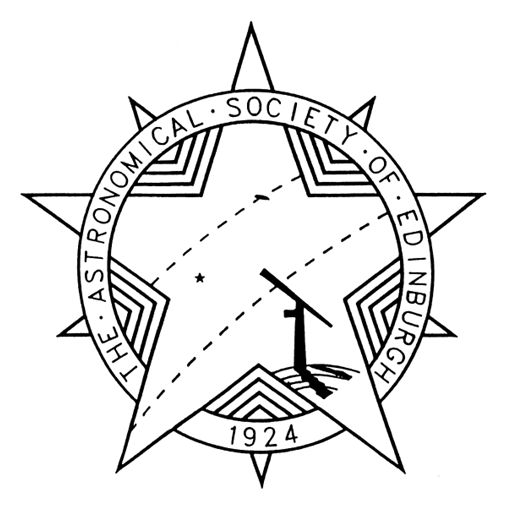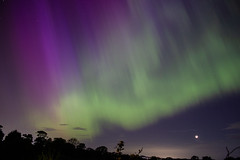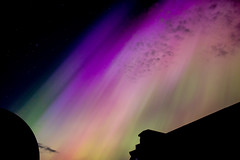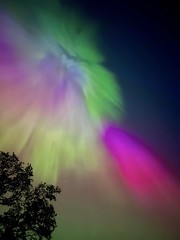Scotland’s Sky in May, 2015
A quarter-century for the Hubble Space Telescope

The maps show the sky at 01:00 BST on the 1st, midnight on the 16th and 23:00 on 31st. An arrow depicts the motion of Venus. (Click on map to englarge)
Just 25 years ago, scientists worldwide were celebrating the successful launch of the Hubble Space Telescope. We soon learned, though, that its precisely-figured 2.4-metre mirror had been built to the wrong shape, and we had to wait another three years before corrective optics could be installed to correct its blurred vision. Since then, Hubble has been returning research and a gallery of stunning images that have transformed our understanding of the Universe.
Its findings impact on every area of astronomy, and every distance-scale, from the farthest and earliest galaxies to the processes of star formation and images of objects in our solar system in unprecedented detail. It has also been a key player in the discovery that the entire Universe is expanding at an increasing rate because of a mysterious entity dubbed dark energy.
It is now six years since a shuttle visited to service it for the final time, and its instruments will eventually fail. Its orbit is also decaying because of the tiny atmospheric drag at its current altitude of 545 km, and it may spiral to destruction within another decade or so.
However, we expect that Hubble will still be alive when its successor, the James Webb Space Telescope, the JWST, is launched, hopefully in 2018. With a segmented 6.5-metre mirror, and working between visible and infrared wavelengths, this should build on Hubble’s legacy. The UK Astronomy Technology Centre at Edinburgh’s Royal Observatory has leading roles in the consortium from Europe and NASA that has built one of the JWST’s three main instruments, the Mid-InfraRed Instrument or MIRI.
As the Sun climbs another 7° higher at noon during May, Edinburgh’s days lengthen by almost two hours, although we lose much more than this of nighttime darkness. On the 1st, the Sun is more than 12° below Edinburgh’s horizon, and the sky effectively dark, for a little more than five hours, but by the month’s end this shrinks to only 32 minutes. More accurately, the sky would be dark for these periods were it not for the moonlight at the start and end of the month.
Sunrise/sunset times for Edinburgh vary from 05:30/20:51 BST on the 1st to 04:37/21:45 on the 31st while the Moon is full on the 4th, at last quarter on the 11th, new on the 18th and at first quarter on the 25th.
The conspicuous star Arcturus in Bootes is climbing in the east at nightfall to dominate the high southern sky by our map times although it pales by comparison with the planets Jupiter and Venus which lie further to the west.
Below and right of Arcturus is Virgo and the closest giant cluster of galaxies, the Virgo Cluster. Located some 54 million light years away, and one of Hubble’s earliest targets, it contains up to 2,000 galaxies, more than a dozen of which are visible through small telescopes under a dark sky. Its centre lies roughly midway between the stars Vindemiatrix in Virgo, and Leo’s tail-star Denebola (see map).
Another planet, Saturn, shines at magnitude 0.0 and almost rivals Arcturus in brightness when it reaches opposition at a distance of 1,341 million km on the 23rd. It is then best placed on the meridian in the middle of the night, though it stands only 15° above Edinburgh’s horizon so that telescopic views of its rings and globe, 42 and 18 arcseconds wide respectively, may be hindered by turbulence in our atmosphere.
Currently 1.2° north of the double star Graffias in Scorpius, Saturn creeps westwards into Libra by the day of opposition. The rings have their northern face tilted 24° towards us at present and although this will increase to 26° next year, Saturn itself slides another 2° further south. Catch Saturn to the right of the Moon on the 5th-6th.
This is the best time this year to glimpse Mercury in our evening sky. Until the 11th, it stands 10° or more above the west-north-western horizon forty minutes after sunset before it sinks to set more than two hours later. It dims from magnitude -0.3 on the 1st to 1.0 on the 11th and may be followed through binoculars for just a few more days as it sinks lower and fades to magnitude 1.7 by the 15th. Mercury stands furthest from the Sun (21°) on the 7th and passes around the Sun’s near side at inferior conjunction on the 30th.
The brilliant evening star Venus improves from magnitude -4.1 to -4.3 and is unmistakable in the west at sunset, sinking to set in the north-west after 01:00. From between the Horns of Taurus at present, it tracks eastwards into Gemini to stand 1.7° above-right of the star cluster M35 on the 9th (use binoculars) and end the month 4° to the south of Pollux in Gemini. Venus approaches from 148 million to 113 million km during the period as its gibbous disk swells from 17 to 22 arcseconds and its sunlit portion falls from 67% to 53%.
Jupiter still outshines every star, but is fainter than Venus and stands above and well to its left, their separation in the sky plummeting from 50° on the 1st to 21° on the 31st. Look for Jupiter in the south-west at nightfall at present and much lower in the west by our map times. This month it fades a little from magnitude -2.1 to -1.9 and tracks 3° eastwards to the east of the Praesepe star cluster in Cancer (use binoculars). The planet lies above the crescent Moon and 833 million km away on the 23rd when a telescope shows its cloud-banded disk to be 35 arc seconds across.
Alan Pickup
This is a slightly-revised version of Alan’s article published in The Scotsman on May 1st 2015, with thanks to the newspaper for permission to republish here.
Posted on 01/05/2015, in Uncategorized and tagged 2015, Alan Pickup, Arcturus, ASE, Astronomical Society of Edinburgh, HST, Hubble Space Telescope, James Webb Space Telescope, Jupiter, JWST, Mars, Mercury, Mid-InfraRed Instrument, MIRI, moon, Night Sky, ROE, Royal Observatory of Edinburgh, Scotland, The Scotsman, UK Astronomy Technology Centre, UKATC, Venus, Virgo. Bookmark the permalink. 2 Comments.




It wasn’t published today in The Scotsman!
Steuart is/was mistaken. It was, indeed, on page 60 of The Scotsman.